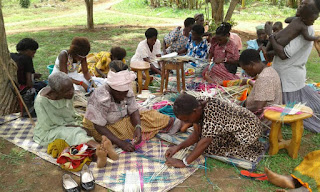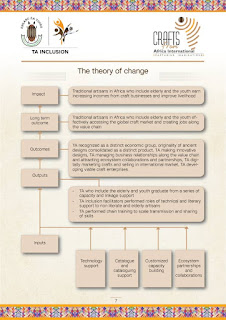The Development Problem
The traditional artisans in Africa are not professionally defined, recognized nor targeted as a distinct and vulnerable production group within the contemporary creative sector. Their ancient craft designs have not been first consolidated as a distinct brand to create its own space in the market before introducing a fusion. This has distorted emergence of clear stages in crafting evolution with their advantage of expanded story diversity and improved market value.
The
capacity development investment in the sector, apart from being too limited to
reach traditional artisans in underserved contexts; its models do not take care
of their unique limitations.
Traditional artisans who are predominantly women rely on traditional skills, hand tools, raw materials, informal distributions, are non literate, digitally excluded and operating from underserved contexts. They lost the traditional craft market as practical uses are replaced by products of modern industries and yet the emerging craft market require adaptive designs, modern business practices and technology enabled marketing. Despite their products losing market, they cling to crafting because it’s the only livelihood skill they have apart from peasantry agriculture where many of them no longer have the physical energy to engage. They form the poorest group in communities and surviving on less than 2 dollars a day.
The Solution
The Traditional Artisans Inclusion (TA Inclusion) is a new and scalable capacity development model designed to define, recognize and target traditional artisans as a distinct production group in creative manufacturing industry in Africa, consolidate their ancient designs as a distinct brand and address their unique limitations to advancing design innovations, viable craft enterprises and digital marketing.
The model has four key action areas;
i.
Three
modules capacity building customized to special needs of traditional artisans
facilitated by toolkits which are adaptable to community programs. The first
module consolidates design heritage and then unlocks the skills and sense of
imagination which responds to the changing needs and lifestyles. This module
evolves into community based incubation centers for design innovations. The
second module introduces basic business practice and enterprise development
while the third introduce technology enabled export marketing.
ii.
Development and periodic updating of craft digital and print catalogue which presents ancient juxtaposed with adaptive designs and ongoing provision of cataloguing skills to artisans.
iii. Continuous
development of digital marketing platform https://www.craftsfromafrica.net/ which is
branded ancient juxtaposed with adaptive designs for enhanced story diversity
and market value.
iv. Establishment
and ongoing management of ecosystem partnerships and collaborations for further
support of the artisan enterprises.
The
model has special features as follows;
-
Consolidating
the originality and authenticity of ancient designs as a distinct brand
-
Use
of community based TA Inclusion facilitators.
-
Pairing
the elderly artisans with their youth successors for intergenerational sharing
of skills and perspectives.
-
Promotion
of a chain training system where one trained artisan trains another as the
chain continues.
Case studies have been identified around the world which prove that traditional artisanship, when given capacity development investment and appropriate models, is market and income viable. Nesta’s partnership with Gee’s Bend Quilting community in USA generated US$ 330,000 income for 31 practitioners in one year by applying capacity development to centuries long quilting tradition and hence turning it into a viable economic option (Nesta, 2021). MADE 51, a craft project of UNHCR has generally achieved the goals of refugee inclusion in the market economy (MADE 51, 2021) just as this model seeks effective inclusion of traditional artisans.
The Theory of
Change
The preconditions
i.
Customized
capacity building of traditional artisans on craft design consolidation and
innovations, business practices and craft enterprises management and technology
enabled export marketing.
ii.
Publication
and periodic updating of catalogue which consolidates ancient juxtaposed with
adaptive designs and ongoing provision of cataloguing skills.
iii.
Technology
support in form of development and ongoing management of digital marketing
platform which brands ancient juxtaposed with adaptive designs.
iv.
Ecosystem
collaborations and partnerships providing further support.
Outputs
-
Traditional artisans who include elders paired with youth graduate from a
process of capacity and linkage building activities.
-
TA Inclusion facilitators performed roles of technical and literacy support to non-literate
artisans.
-
Traditional artisans performed chain training to scale transmission of skills.
Outcomes
After
undergoing a complete process of capacity and linkage building activities,
traditional artisans who include elderly and the youth are increasingly
consolidating ancient designs as a distinct product and linking it to its
relevant market. They are also making innovative designs, responding to
emerging needs and connecting products to the global market through digitally
enabled marketing. They are managing business relationships with value chain
partners and building viable enterprises which are attracting further training,
business financing, capital investments and marketing partnerships from
ecosystem institutions at national and international levels. Ancient and
adaptive designs have emerged as clearly separate product categories, creating
diversity of themes and uses with associated increased market value.
Traditional
artisans in Africa who include the elderly and youth competitively accessing
the global craft market and effectively integrated in design and creative
manufacturing sector and creating jobs across the value chain.
Traditional
artisans in Africa who include the elderly and youth and predominantly of
female gender increasingly improve incomes, livelihood and welfare.
1.
The
economic, political, social and health environment in the targeted countries
remain conducive.
2.
The
most effective way of enabling poor traditional artisans to get income is to
develop the market of their craft products.
3.
Consolidating
the originality of ancient designs of craft can increase market value and
benefits to traditional artisans.
4.
The
employed unique strategies can enable traditional artisan uptake the capacity
building.
5. Traditional artisans will access sufficient internet connectivity for their digital marketing of crafts.




No comments:
Post a Comment